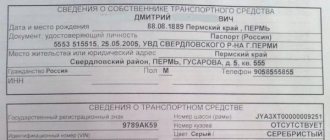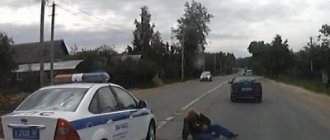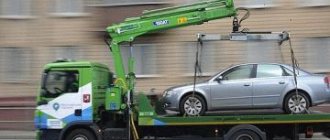What is written about driving in the left lane in the traffic rules?
Answers to all questions about driving in the left lane are contained in clauses 9.4 and 9.5 of the traffic rules. For the most part, the bans apply to suburban routes:
- Outside populated areas, you cannot drive in the left lane, except when turning left or ahead. The same applies to other roads on which driving at speeds over 80 km/h is permitted if they are marked with signs 5.1 (motorway) or 5.3 (road for cars, motorcycles and buses).
- In populated areas you can drive in any lane, with some exceptions. For example, if the maximum speed of a vehicle does not exceed 40 km/h, the driver can only move on the far right. The exception is turns, U-turns, and avoidance of obstacles: in this case, driving to the left is allowed.
- If there are three or more lanes on the road. Here, location does not matter: you can occupy the far left lane only if the other two are occupied by other cars and there is heavy traffic. You are also allowed to exit only to turn left or make a U-turn.
Vehicles with a permissible maximum weight of 2.5 tons may enter the leftmost lane of three or more lanes only to make a U-turn or turn left.
Let's look at a few examples of how this should look in practice:
No. 1. Driving through a populated area. The driver is driving on a two-lane road, taking the extreme left position. There is no violation here: clause 9.4 of the traffic rules contains no prohibitions. Then the number of lanes changes, and there are already three in the same direction. Here the driver can take the far left lane only if the remaining lanes are occupied during active traffic, or he needs to turn left or turn around.
It is worth considering signs and markings. Even if when driving in a city there are two lanes, but there are signs indicating the direction of travel, you need to be guided by them. For example, you cannot drive straight in the left lane if the sign indicates that on this section of the road you can only turn around or turn left.
No. 2. Driving outside the populated area. The end of a populated area is indicated by sign 5.24.1, but restrictions can also be lifted by sign 3.31. A man is driving a car in the right lane. The car ahead is moving at a lower speed, so the other driver is allowed to get ahead of it. After completing the maneuver, he must return to his lane.
Many drivers have an unspoken rule that will help avoid some unpleasant situations. Despite the fact that driving in the city in the left lane is in most cases allowed according to traffic regulations, experienced car owners consider driving there with a free right lane considered bad manners.
Another issue is when both lanes are occupied and the car on the left is driving just as slowly as the one on the right. In fact, it turns out that the entire road is occupied, and those who are driving faster than them from behind will not be able to pass, or they will have to drive into oncoming traffic in violation of traffic rules. According to the rules, both drivers in front are right, but in order to avoid traffic conflicts, it is better not to do this.
Am I required to yield to the left lane?
A fairly common situation: you are moving on the far left, when another car catches up with you from behind, starts blinking its high beam headlights, and honks (or doesn’t). Is the driver obligated to give way in this case to a car approaching from behind? In this situation:
No, there is no direct such obligation. Although you are breaking the Rules if the lane on the right is free. But please note that in this case, the person approaching from behind also violates, moving in the left lane with free right-hand lanes, regardless of your traffic violation. So, should the one who violates the most change to the right? Not at all.
But both you and the person driving behind you must move to the right lane. It’s just that since the one moving behind initially goes faster than you, he will again have to return to the left in order to get ahead of you. Therefore, it would be most reasonable for you to change lanes to the right... Unless, of course, the right is free, and you do not need to turn left soon. But the opinion that the left lane is intended for “flyers” is a misconception. Even if you are driving at least 250 km/h, if the right lanes are empty, you must change lanes to the right.
But there is a situation when you are obliged to vacate the left lane. This is when you are ahead of another car, and the car behind is moving at a speed higher than yours. Like this:
You, as the driver of a green car, do not give way to a red one, but only fulfill the obligation to change lanes to the right
Should I speed up?
And it depends on the specific road situation and your speed. On the one hand, you do not have a direct obligation to give way to the left lane, even if the car behind you is not speeding. On the other hand, traffic rules prohibit moving at a deliberately low speed unless necessary, creating interference with other vehicles. And, if there are other cars driving to your right, and you cannot change lanes, then you are creating an obstacle for a car driving at the permitted speed behind you by moving too slowly.
Therefore, if you, for example, drive 50 km/h when the permitted speed is 90, then you may be violating, although no one can prove that you do not need to drive slowly. But the Rules do not describe the criteria for too low a speed. Therefore, even 85 km/h when the permitted 90 may or may not be so, depending on the assessment of the person examining the violation or the judge.
When is it legal to drive in the left lane?
There are several situations when you can drive into the left lane without fear of a fine:
- if there is another car ahead and you need to overtake it;
- if there is an obstacle on the right in the form of an accident, road work, etc.;
- if the driver wants to turn around or turn left;
- if the right side of the road is broken and driving on it is dangerous.
If we are talking about an area outside the city or about driving on a three-lane road in the city, after completing any of the above maneuvers, you need to return to your lane. The left side cannot be occupied, even if it is empty and there are no other vehicles behind that could be interfered with by the car.
Lane traffic signs
Signs regulating traffic within the boundaries of road lanes belong to the group of special regulations. They are installed at an intersection and have the right to override other signs provided for that intersection.
Direction
Sign 5.15.1 indicates how many lanes there are on the road and shows the direction in which traffic is allowed.
For example, this sign prescribes and allows:
- turn from the right lane to the right;
- straight ahead in the left and center lanes;
- turn or make a U-turn from the left lane.
The instructions of sign 5.15.2 are similar to the instructions of the previous one. There is also a difference: the pointer is placed above a certain strip. Its action extends to regulating the movement of a specific lane.
These signs have a number of features:
- a sign allowing a left turn does not prevent a U-turn;
- These signs are not used for public transport.
When there is more traffic flow in one direction than in the other, a similar sign is used: 5.15.7. The sign may be supplemented with restrictions on the speed limit and type of vehicle.
Beginning and the end
Sign 5.15.3 is most often installed when climbing or when approaching a braking lane. He warns: an additional strip will appear soon.
Sometimes the sign is supplemented with an indication of the minimum speed limit for cars. This means that in this lane you must adhere to the speed limit indicated on the sign. Or move at a higher speed, but within the general acceptable limits.
The Rules contain sign 5.15.4, which also warns about the start of an additional lane in the middle of the road of 3 lanes. Sometimes it contains instructions for certain vehicles.
Signs 5.15.5 and 5.15.6 indicate the end of any additional lane.
Number
This sign informs about the number of road lanes and informs about the mode of movement.
Sign 5.15.7 is installed in advance: 50-150 m before the road prohibitions posted on the stripes.
What is the fine for driving in the left lane?
If the driver violates clause 9.4 or clause 9.5 of the traffic rules, he may be held accountable under Part 1 of Art. 12.15 of the Code of Administrative Offenses for violating the rules for placing a car on the road. The fine here is 1,500 rubles.
Only a traffic police inspector can record a violation. Cameras recording non-compliance with clause 9.4 or clause 9.5 of the traffic rules have not yet been installed anywhere. A protocol is drawn up on site, which will immediately indicate the details for payment.
If you pay the fine within 20 days, you can take advantage of a discount of 50% of the amount. In the end, only 750 rubles are transferred instead of 1,500 rubles.
Dear reader! Didn't receive an answer to your question? Our expert lawyers work for you. It's absolutely free!
- Moscow ext 152
- St. Petersburg ext 152
- All regions ext 132 (Toll free)
Is it possible to drive in the left lane within the city?
As mentioned earlier, clause 9.4 of the traffic rules applies only to suburban sections of roads. In the city, you can drive in any lane, the main thing is to follow the instructions of the signs and markings.
However, initially the left lane is intended for turns, driving left and overtaking. If you drive it straight, there will be no fine for it. An exception is certain types of vehicles that are prohibited from driving on the left unless absolutely necessary:
- heavy trucks;
- towed and towing vehicles;
- vehicles that technically cannot accelerate to a speed of more than 40 km/h;
- faulty cars whose drivers drive with their emergency lights on.
The above categories of vehicles can drive on the road on the left only if their drivers intend to turn left or make a U-turn.
How fast can you drive outside the city?
Every driver understands that driving on roads and in populated areas is different. In cities, the speed limit is usually 40-60 km/h.
If you don’t know what the maximum speed is outside the city, you need to look at the traffic rules and also open paragraph 10.3. Here is a section on movement speed.
If the road is not a motorway, then wheeled vehicles weighing up to 3.5 tons are allowed to travel up to 90 km/h. Speed limits are prescribed for specific types of transport.
In each case, the numbers “NO MORE THAN” a certain value are indicated. If it is 90 km/h, then the traffic rules allow driving no higher than 90 km/h.
At the same time, the system of sanctions allows us to deviate somewhat from this rule. The speed limit actually increases by 20 km/h. That is, when driving at a speed of 110 km/h, where the limit is 90 km/h, the driver will not be fined for speeding.
The driver himself determines whether this opportunity will be used or not.
It is important to remember the use of 3.24 signs. Installed to limit speed limits. If there are signs, you need to follow them.
Speed limits
If you are interested in the speed of movement outside a populated area, then take a look at the following list.
Outside populated areas the following can drive 90 km/h:
- passenger cars;
- trucks with a permissible mass of up to 3.5 tons;
- motorcycles;
- intercity and small buses.
For several categories of vehicles outside the city, the limit will be 70 km/h:
- passenger cars equipped with a trailer;
- trucks whose permissible weight exceeds 3.5 tons;
- other types of buses.
If it is a truck with passengers in the back, or there is an organized transportation of children, then the speed limit is 60 km/h.
When towing a vehicle, it is not allowed to accelerate to more than 50 km/h.
The situation changes somewhat if it is a motorway. Then, outside populated areas, drivers are allowed to drive at the following speed:
- 110 km/h
. Valid for cars, trucks up to 3.5 tons and motorcycles; - 90 km/h
. Relevant for passenger cars with trailers, trucks over 3.5 tons, intercity and small buses, as well as for other types of buses; - 60 km/h
. Applies to trucks with passengers in the back, as well as the organized transportation of children; - 50 km/h
. If a motor vehicle is being towed.
Again, there is a non-punishable limit of 20 km/h.
What should you do if you were driving in the left lane and stopped by a traffic police officer?
Despite the provided liability, it is extremely problematic to be held accountable for driving in the left lane on a section of the road where it is prohibited unless necessary. Inspectors will have to prove that the driver violated traffic rules. He, in turn, can explain driving on the left as follows:
- the right lane was occupied by another car traveling at a lower speed, and it was necessary to get ahead of it;
- There was an obstacle in the right lane that we had to go around: a hole, a pothole, an accident.
Most often, drivers explain driving in the left lane by looking for a left turn. Inspectors have no right to punish for this. If the protocol is nevertheless drawn up, you need to make a note of disagreement on it and indicate the reasons. After this, the protocol can be challenged through the court or the head of the traffic police.
I am driving at the maximum speed limit and can take the left lane - is this true?
No! One of the most common myths is that if you drive at the highest speed limit, you can occupy the left lane, regardless of the road section and conditions listed above. The roots of this myth lie in the logical chain of obligation to give way to the left lane to someone who is driving faster - in our case, there is no one to give way to except those who violate the speed limit.
The truth is that even if you are driving, for example, 110 km/h when the speed limit is 90, you do not have the right to move in the left lane. Traffic rules generally prescribe prohibitions on occupying it in the cases listed above, regardless of speed.










